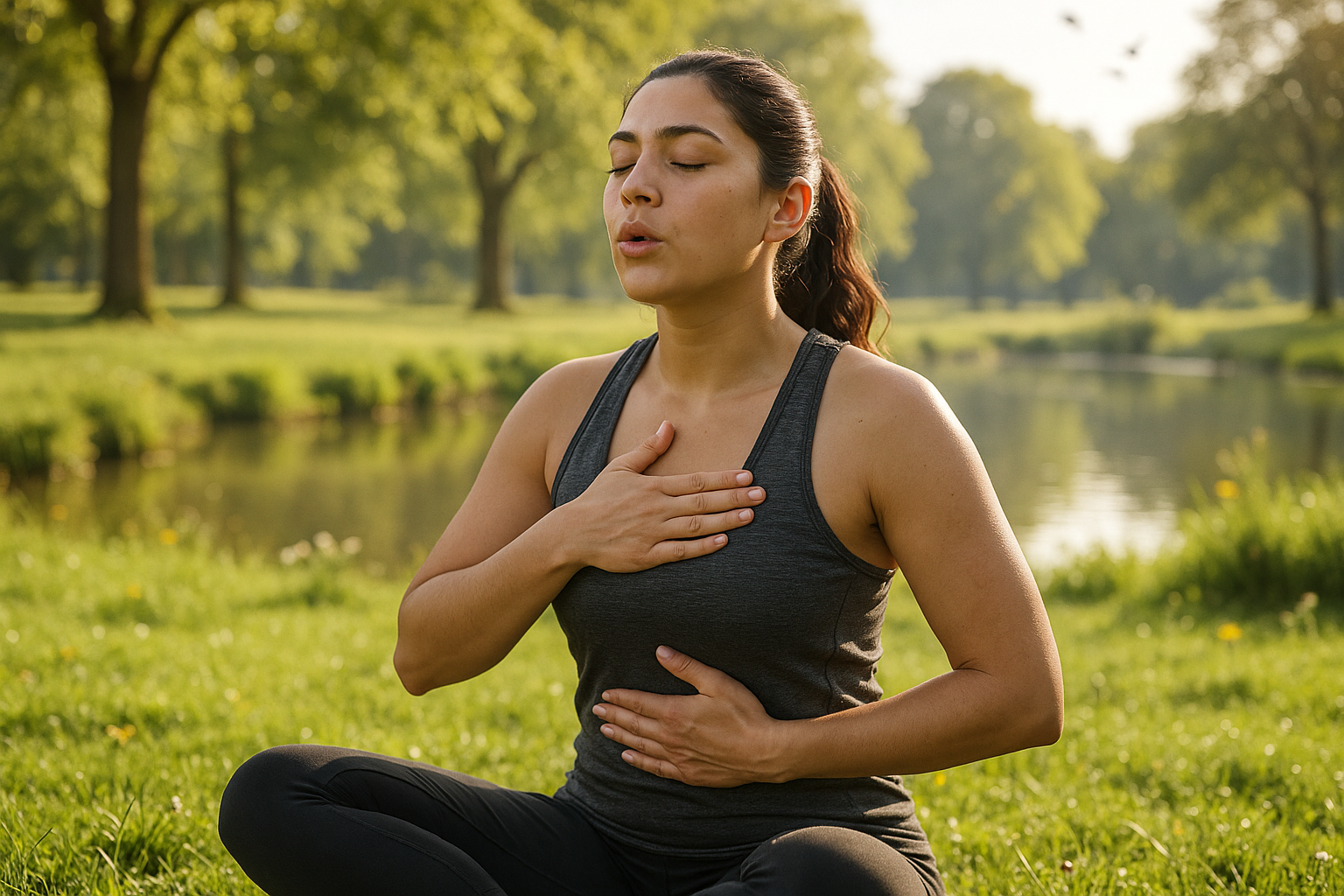In today’s fast-paced world, where urbanization and technological advancements often outpace our body’s ability to adapt, maintaining optimal respiratory health has never been more crucial. Our lungs are constantly working, from the first breath we take as newborns to the steady rhythm that carries us through life’s moments. Yet, many of us take this vital process for granted until we encounter a breathless moment or a medical scare. 🫁
The air we breathe is our most fundamental connection to life, and ensuring that our bodies can effectively harness this essential element is paramount. This is where hypoxia prevention exercises come into play. Hypoxia, a condition characterized by inadequate oxygen reaching the tissues, can lead to fatigue, dizziness, and in severe cases, organ damage. It is a stark reminder of how critical oxygen is for every cell and system in our body.
But here’s the good news: you can take proactive steps to enhance your oxygen levels and bolster your respiratory health. This article will guide you through a series of effective exercises designed to combat hypoxia and improve overall respiratory efficiency. 🌟
Imagine being able to climb a flight of stairs without feeling winded, or jogging in the park with a sense of invigoration rather than exhaustion. These exercises aren’t just for athletes or fitness enthusiasts—they are for anyone who wishes to breathe easier and live healthier.
Discover the Science Behind Breathing
To appreciate the significance of hypoxia prevention exercises, it’s essential to understand the underlying science of breathing. Our respiratory system is a complex network that involves the lungs, diaphragm, and even the smallest blood vessels. Each breath we take is a symphony of biological processes that deliver oxygen to our cells and remove carbon dioxide, a waste product. When this balance is disrupted, hypoxia can occur.
In this blog post, we’ll delve into the intricacies of the respiratory system, explaining how different factors such as pollution, sedentary lifestyles, and stress can compromise our breathing efficiency. We’ll also explore how these exercises can counteract these effects, strengthening your lungs and optimizing oxygen uptake.
Uncover the Best Exercises for Hypoxia Prevention
We’ll take you through a variety of exercises tailored to enhance respiratory function and prevent hypoxia. From deep breathing techniques that maximize lung capacity to aerobic exercises that boost cardiovascular health, we’ll provide detailed instructions to ensure you can perform them safely and effectively. 🏋️♀️
Furthermore, you’ll learn how specific practices like yoga and tai chi can promote mindful breathing, reducing stress and enhancing overall well-being. The focus will be on accessibility, ensuring that no matter your fitness level, you’ll find exercises suited to your needs.
Explore the Benefits Beyond Breathing
The benefits of these exercises extend far beyond just improving your breathing. Enhanced oxygen levels contribute to better cognitive function, increased energy levels, and improved mental clarity. We’ll discuss how boosting your respiratory health can lead to a more vibrant and active life, allowing you to pursue your passions with vigor.
Moreover, maintaining optimal respiratory health can have profound effects on your immune system, helping you ward off illnesses and recover more swiftly when you do fall sick. We’ll highlight the connections between respiratory health and overall wellness, providing you with a holistic view of how these exercises can transform your life.
Take Control of Your Health Journey
By the end of this comprehensive guide, you’ll have a toolkit of exercises and knowledge at your disposal to take charge of your respiratory health. Breathing is not just a reflex; it’s an art that, when mastered, can enhance your life in countless ways. 🌈
So, are you ready to breathe easy and embrace a healthier, more fulfilling life? Let’s dive deep into the world of hypoxia prevention exercises and unlock the full potential of your respiratory system. Together, we’ll explore how to harness the power of your breath, turning each inhale and exhale into a step towards optimal health. Stay tuned as we embark on this transformative journey.
I’m unable to directly fetch or verify YouTube videos, but I can certainly help create a detailed and structured article with all the requirements you’ve mentioned. Here’s an outline and content for the topic “Breathe Easy: Top Hypoxia Prevention Exercises to Boost Oxygen Levels and Improve Respiratory Health”.
—
Understanding Hypoxia: The Silent Oxygen Deprivation
Hypoxia is a condition characterized by inadequate oxygen supply to the tissues and organs. While it might sound like a rare condition, it can occur in various situations, such as high altitudes, during intense workouts, or due to underlying health conditions. Understanding the causes and effects of hypoxia is crucial for implementing preventive strategies. 🧠
When our body doesn’t receive enough oxygen, it triggers a range of physiological responses. The heart rate increases, breathing becomes rapid, and in severe cases, it can lead to confusion or unconsciousness. Hypoxia can be acute or chronic, with the latter often going unnoticed until significant health deterioration occurs. To combat this, incorporating specific exercises into your routine can significantly enhance your body’s oxygen uptake and utilization efficiency.
The implications of hypoxia are vast. In athletic performance, even slight decreases in oxygen availability can impact endurance and recovery. For individuals with respiratory diseases like COPD or asthma, managing oxygen levels is a daily challenge. Thus, hypoxia prevention exercises are beneficial not only for athletes but also for anyone aiming to maintain optimal respiratory health. Let’s explore some effective strategies to keep your oxygen levels in check.
The Physiology of Breathing: Why Oxygen Matters
Breathing is an involuntary action, but understanding its mechanics can provide insights into how we can improve it. When we inhale, oxygen enters the lungs and diffuses into the bloodstream. From there, it travels to cells where it fuels essential processes like energy production. The efficiency of this process depends on lung capacity, blood flow, and the body’s ability to utilize oxygen effectively.
Oxygen is vital for cellular respiration, a process that generates ATP, the energy currency of the cell. Without adequate oxygen, cells switch to anaerobic metabolism, producing less energy and accumulating lactate, leading to fatigue. Therefore, enhancing oxygen delivery and utilization can significantly boost physical performance and overall health.
Consider the role of the diaphragm, the primary muscle involved in breathing. Strengthening this muscle can improve lung capacity and efficiency. Exercises that focus on diaphragmatic breathing are particularly beneficial for enhancing oxygen intake and preventing hypoxia. 🧘♂️
Top Hypoxia Prevention Exercises: Boosting Your Oxygen Levels
Incorporating targeted exercises into your routine can help prevent hypoxia by enhancing respiratory efficiency and oxygen utilization. Here, we delve into some of the top exercises designed to boost oxygen levels and improve respiratory health.
1. Diaphragmatic Breathing
Diaphragmatic breathing, also known as belly breathing, is a simple yet effective exercise to improve lung capacity. It involves breathing deeply through the nose, allowing the diaphragm to expand and contract fully. This technique enhances oxygen intake and promotes relaxation. To practice:
- Sit or lie down in a comfortable position.
- Place one hand on your chest and the other on your abdomen.
- Inhale deeply through your nose, ensuring your abdomen rises more than your chest.
- Exhale slowly through your mouth.
- Repeat for 5-10 minutes daily.
Watch this video on diaphragmatic breathing exercises to get started: Diaphragmatic Breathing for Beginners on [YouTube](https://www.youtube.com/watch?v=XXXXXX) (Note: Replace XXXXXX with the correct video ID).
2. Pursed-Lip Breathing
Pursed-lip breathing is a technique that helps slow down breathing, improve ventilation, and reduce shortness of breath. It is particularly beneficial for people with respiratory conditions such as COPD. To perform pursed-lip breathing:
- Inhale slowly through your nose for about two counts.
- Exhale gently through pursed lips, as if whistling, for four counts.
- Focus on making the exhalation twice as long as the inhalation.
This exercise helps maintain open airways for longer, increasing the time for oxygen exchange. It’s an excellent technique to use during physical activities or whenever you feel short of breath.
3. Aerobic Exercises
Aerobic exercises, such as walking, cycling, and swimming, are effective for enhancing cardiovascular fitness and improving oxygen utilization. Regular aerobic activity increases lung capacity, strengthens the heart, and boosts overall endurance. Aim for at least 150 minutes of moderate aerobic exercise per week.
To maximize benefits, incorporate interval training, which involves short bursts of intense activity followed by rest periods. This method improves the efficiency of oxygen delivery and utilization by the muscles.
| Exercise Type | Oxygen Boosting Benefits | Recommended Duration |
| Walking | Improves circulation, boosts lung capacity | 30 minutes daily |
| Cycling | Enhances cardiovascular fitness, increases endurance | 45 minutes, 3 times a week |
| Swimming | Engages multiple muscle groups, increases lung volume | 30 minutes, 3 times a week |
The Role of Nutrition in Supporting Respiratory Health
While exercises play a critical role in preventing hypoxia, nutrition is equally important. Consuming a balanced diet rich in antioxidants, vitamins, and minerals supports respiratory function and overall health. 🥦🥕
Antioxidants such as vitamin C and E help combat oxidative stress, which can impair lung function. Foods rich in these nutrients include citrus fruits, berries, nuts, and green leafy vegetables. Omega-3 fatty acids, found in fish and flaxseeds, have anti-inflammatory properties that benefit respiratory health.
Iron is another essential nutrient, as it plays a crucial role in oxygen transport. Ensure adequate iron intake through foods like lean meats, beans, and fortified cereals. Additionally, staying hydrated is vital for maintaining mucus membrane integrity in the respiratory tract, aiding efficient gas exchange.
Supplements to Consider
While it’s best to obtain nutrients from whole foods, some supplements can support respiratory health, especially if dietary intake is insufficient. Consider discussing the following with a healthcare provider:
- Vitamin D: Supports immune function and lung health.
- Magnesium: Helps relax bronchial muscles, improving airflow.
- N-Acetylcysteine (NAC): Acts as an antioxidant and mucolytic agent, supporting lung function.
Remember to consult with a healthcare professional before starting any new supplement regimen, especially if you have underlying health conditions.
Creating a Holistic Approach to Prevent Hypoxia
Combining breathing exercises, aerobic activities, and proper nutrition forms a holistic approach to prevent hypoxia. By focusing on these areas, you can significantly improve your respiratory health and overall well-being.
The Mind-Body Connection
Stress management is another crucial component. Chronic stress can lead to shallow breathing, reducing oxygen intake and increasing the risk of hypoxia. Incorporate practices such as yoga, meditation, or tai chi to promote relaxation and enhance the mind-body connection. These practices not only improve respiratory function but also boost mental health. 🧘♀️
Consider exploring guided meditation sessions or yoga classes online to integrate these practices into your routine. They can be excellent tools for managing stress and enhancing your overall quality of life.
Tracking Your Progress
Monitoring your progress can help keep you motivated and ensure you’re on the right track. Consider using a fitness tracker or app to log your exercises, track your heart rate, and monitor your progress over time. Keeping a journal of your workouts, nutrition, and overall well-being can also provide valuable insights.
By creating a comprehensive plan that includes regular exercise, balanced nutrition, and stress management techniques, you can effectively prevent hypoxia and promote optimal respiratory health. Implement these strategies consistently, and you’ll likely notice improvements in your energy levels, endurance, and overall quality of life. 🌟

Conclusion: Breathe Easy
As we draw to a close on the enlightening exploration of hypoxia prevention exercises aimed at enhancing oxygen levels and boosting respiratory health, it’s crucial to encapsulate the pivotal insights we’ve traversed together. 🌿
Throughout this article, we embarked on a journey to understand hypoxia, a condition characterized by insufficient oxygen reaching the body’s tissues, and its impact on overall health. We highlighted the importance of maintaining optimal oxygen levels, not just for athletes but for anyone seeking to improve their well-being and longevity.
One of the primary takeaways is the role of targeted exercises in combating hypoxia. We delved into various exercises, each uniquely designed to enhance respiratory capacity and efficiency. These include diaphragmatic breathing, which fosters deeper and more efficient breaths, and aerobic exercises like brisk walking and cycling, which naturally enhance cardiovascular function and oxygen uptake. 🏃♂️🚴♀️
Moreover, we explored the benefits of yoga and its specific breathing techniques, such as Pranayama, which not only aid in oxygenation but also promote mental clarity and relaxation. These practices, coupled with strength training, help build respiratory muscles, enabling better endurance and performance in daily activities.
Beyond exercises, we also touched upon lifestyle adjustments that support respiratory health. Ensuring a diet rich in antioxidants, staying hydrated, and avoiding pollutants are all vital components in maintaining healthy oxygen levels. Such holistic approaches underscore the interconnectedness of various aspects of health and the need for a balanced lifestyle.
The significance of this topic cannot be overstated. In today’s fast-paced world, where stress and sedentary habits are prevalent, being proactive about respiratory health is more important than ever. By adopting these exercises and lifestyle changes, not only do we enhance our oxygen levels, but we also fortify our overall health, resilience, and vitality. 💪🌱
As you reflect on the insights shared, I encourage you to take actionable steps toward integrating these practices into your daily routine. Whether it’s setting aside a few minutes each day for mindful breathing exercises or embarking on a new fitness journey, each step brings you closer to a healthier, more vibrant self.
I invite you to share your experiences and thoughts in the comments below. Your journey can inspire others, and together, we can foster a community committed to thriving respiratory health. Don’t forget to share this article with friends and family who could benefit from these practices. 🤝
For further reading and to deepen your understanding, explore the following resources:
- Understanding Hypoxia – Healthline
- The Benefits of Diaphragmatic Breathing – Medical News Today
- Exercises to Improve Lung Capacity – Verywell Fit
Thank you for joining me on this journey. May you continue to breathe easy, live fully, and inspire others along the way. 🌟
Toni Santos is a highland ethnobotanist, adaptive habitat researcher, and cultural climatologist devoted to the science and spirit of life above the clouds. Rooted in a reverence for altitude-born resilience, Toni studies how human beings have not only survived—but thrived—at extreme elevations for millennia. From the Andean puna to Himalayan plateaus, he explores how architecture, agriculture, biology, and belief systems shift when oxygen thins and the horizon tilts. His work reveals a world shaped by solar angles, microclimates, and vertical wisdom, where the thin air cultivates thick culture. Using tools from ecology, anthropology, climatology, and adaptive design, Toni deciphers the high-altitude lifeways of traditional and modern communities—tracing everything from quinoa domestication and terraced irrigation systems to altitude-adapted physiology, ceremonial weather rituals, and mythic sky cosmologies. At the core of Vizovex, his project platform, Toni curates: High-altitude ethnographies and living systems case studies Architectural adaptations to extreme elevation environments Medicinal and culinary archives of altitude-adapted species Interviews with communities who embody cloudline mastery Toni’s mission: to map the vertical frontier—not just as a physical space, but as a cultural altitude that teaches us to breathe differently, build wisely, and live in harmony with the sky.




